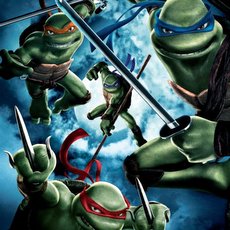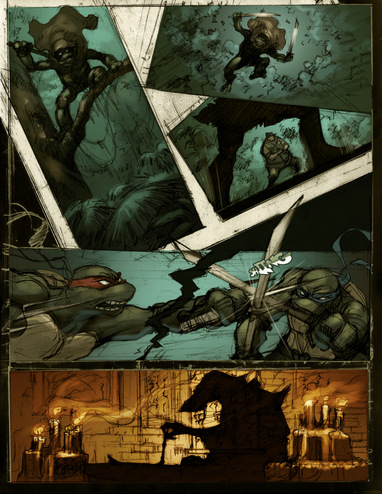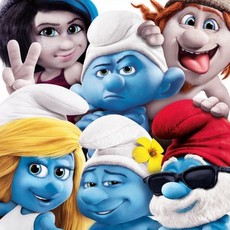The Michael Bay-produced Teenage Mutant Ninja Turtles finds the “heroes in a half shell” leaping back onto the big screen after a seven-year hiatus. However, if things had gone according to Imagi Animation Studios’ plan, audiences would have seen a much different Turtles film this year: the third installment of the computer animated TMNT trilogy.
Released in 2007, TMNT was the first major feature from Imagi. It was also the latest incarnation of the Turtles on the big screen, after a fourth live-action film failed to get off the ground in 1994 and 2001.
Kevin Munroe lobbied hard for Turtles co-creator Peter Laird’s approval to make TMNT. Munroe wanted to show audiences that the Turtles could be as dark and complex as they were comedic. Per Laird’s blessing, Imagi gave Munroe the green light to write and direct TMNT.

Early promotional artwork for TMNT
For an assistant director, Munroe looked to Tom Tanaka, with whom he had worked on video games since 1995. “Tom was the first guy that I told I was doing TMNT, and was the only one who didn’t scrunch up his face wondering why I would do that,” says Munroe. “At the time, it wasn’t as obvious as it would be now in our post-Marvel movie world.” Munroe and Tanaka crafted a story in which Leonardo, Raphael, Donatello and Michelangelo reunite to stop Aztec warriors and immortal monsters from unleashing chaos in present-day New York City.
Distributed by Warner Bros. and The Weinstein Co., TMNT opened in theaters on March 23, 2007. Doing press interviews for the film, Munroe said he had already been brainstorming ideas for the sequel. Speaking with Animated Views in 2007, he noted several villains in consideration for future TMNT films:
“Shredder — it would be cool to see. I’d love to see us explore the Karai and Foot Ninja thing a little more. I love the Rat King, even though he’s such a one-opp villain, but I still think it would be kind of cool to go back to him. I’d love to use — and this is sort of the ‘out there’ one, as I don’t think it would work for our next sequel — the Triceratons. I think that would be really fun — the idea of traveling to that planet or them invading or something.”
During that interview, Munroe also revealed one sequel idea that had already been nixed by Laird: The Turtles go back in time to explore Mayan culture, just as an evil alien race also arrives via teleportation. According to Munroe, Laird’s response was, “Eh, we did it in 1992,” a reference to Teenage Mutant Ninja Turtles III: Turtles In Time.

Analysts were cautious when predicting how TMNT would perform its opening weekend. Most believed it would arrive in third place, behind fellow newbie Shooter and the already-successful 300. “We were in Hong Kong for the premier, with most of the crew and our department heads. On Friday, I got a call from [producer] Tom Gray saying that it was looking like the third place we all were told,” recalls Munroe. “A few hours later, it was a different picture – older TMNT fans were getting out of work and seeing the film, and the numbers started going up. And suddenly, the weekend looked bigger.
“We woke up on Sunday morning knowing it was #1. It was a good breakfast.”
TMNT collected $24.3 million its opening weekend, getting a decent-sized return on its reported $34 million budget. In addition, the film received a promising “A-” score from moviegoer pollster CinemaScore. But critics were divided on TMNT, praising the visuals yet desiring a simpler plot and humor more akin to that of its live-action predecessors.
“I’ve come to not really listen to critics anymore, but I would say that it was a fair critique from the fan base at the time,” says Munroe. “It looked amazing and was a fun thrill ride. But I think the story was too complicated in the final product. A number of things led to that, from the type of story that Pete [Laird] wanted told, to my way of constructing a film, and to the studios trying to recut it at the last minute and make it a more, I guess, ‘straightforward’ kid film.”
By the end of its 13-week theatrical run, TMNT had grossed $54 million domestically, while adding another $41.5 million from foreign territories. This encouraged Imagi to invest in a sequel.
Some fans speculated that TMNT had already laid the groundwork for a sequel. While certain dialogue in the film hinted at the return of Shredder, a scene in which Splinter stands at his archive of mementos contained several references to villains such as the Triceratons and the Mousers. The mementos also included Shredder’s helmet and the time scepter from the live-action films.
“The memento wall was a way to try and have TMNT play in continuity with the earlier, live-action films,” explains Munroe. “I probably would have done a complete reboot if presented with the idea. But Pete was pretty adamant about not doing a reboot while not necessarily having TMNT play with the rest of the franchise. So, I just took a stand and said, ‘Yes, TMNT exists with the other films.'”
Munroe already had the blueprints in place for future films. TMNT 2 would have loosely adapted the Turtles’ 13-part comic book saga City At War: Michelangelo feels like the “odd man out” among his brothers, not being taken seriously. With the best of intentions, the character runs away and joins the Foot Clan, donning a black bandana. Meanwhile, the Turtles travel to Japan and cross paths with Karai in an adventure resulting in the return of their arch nemesis, Shredder. (Fans hoping for the return of Bebop and Rocksteady would have been out of luck. As with the ’90s live-action movies, the legal rights to use Shredder’s most famous minions were not part of the package.)
TMNT 3 would have featured the Triceratons as well as the Technodrome’s arrival from Dimension X, with Donatello being a catalyst for these events.
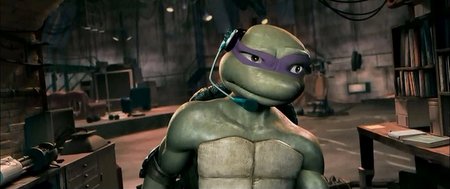
“To me, that would have been the great third part to that trilogy,” says Munroe. “The first movie is about family and reclaiming the city. The second movie is about the boys growing up, losing Splinter and then inheriting their father’s war. And the third movie opens up their world on a level no one would have seen in a Ninja Turtles movie before.”
Munroe and Imagi were lining up Tanaka to co-direct TMNT 2 or direct TMNT 3. Munroe wanted Michael Clarke Duncan to voice the Triceraton’s leader, Commander Mozar. He even had poster designs already in mind for TMNT 2 (“a wet city street and, by a manhole cover, Mikey’s orange bandana lying on the ground”) and its sequel (“the Technodrome with the Turtles very small in the foreground”).
But Munroe and Tanaka could not immediately jump onto the TMNT sequels for at least one major reason: They were already working on Gatchaman, a movie update of Tatsuo Yoshida’s anime series about a five-member superhero team. In fact, Munroe had been working on the Gatchaman screenplay six months before TMNT was released.
Once TMNT was in theaters, Mulan II co-director Lynn Southerland joined Gatchaman, to assist with the screenplay. Tanaka signed on as co-director. Paul Dini, best known as an Emmy-winning writer for Batman: The Animated Series, contributed another draft of the screenplay. Imagi went with Munroe and Tanaka’s pitch for a PG-13, computer animated, western anime take on the source material. Then the studio turned it into Power Rangers – or, at best, a lightweight imitation, according to Munroe. “Softer, more fun,” he says. “Then the rudder sort of broke on the project.” After two years of work, Munroe left Gatchaman – and Imagi. The future of the TMNT franchise became uncertain.
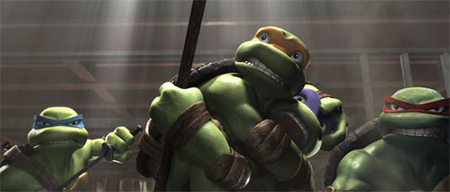
Munroe moved onto Dylan Dog: Dead Of Night, an adaptation of the Dark Horse comic series about a private investigator who takes on the undead. It allowed Munroe to try his hand at directing a live-action feature.
“It was an incredible break from animation,” says Munroe, “as I think animation has a tendency to make you a little arrogant. You create everything in a world, think you have answers for everything, etc. So, I think it’s the ultimate challenge for animation directors – jumping to live-action where you don’t have that control.”
Munroe was not the only one who left Imagi – the Turtles did, too. In April 2009, The Mirage Group celebrated the Turtles’ 25th anniversary by announcing a new live-action movie would hit theaters in 2011. To bring the reptilian characters to life, the filmmakers were to use animatronic suits whose facial expressions would be digitally enhanced in post-production, a la Spike Jonze’s Where The Wild Things Are. Those plans were scrapped when, a mere six months later, Nickelodeon acquired the global rights to the Turtles brand for $60 million.
Imagi’s Astro Boy entered theaters in October 2009, based on Osamu Tezuka’s Japanese manga series. Despite a voice cast that included Nicolas Cage and Charlize Theron, the movie failed to recoup its $65 million budget, collecting a mere $40 million worldwide.
Without the Turtles, Imagi’s future looked bleak following the failure of Astro Boy. In February 2010, parent company Imagi International Holdings Ltd. announced it had shut down the animation studio.
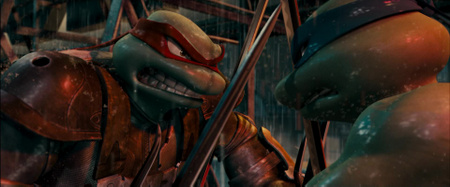
“I was sad, in a way. In another, I wasn’t surprised a bit,” says Munroe. “I continue to learn, to this day, from that experience.
“TMNT was created in a way I have yet to experience again. It was artists all making a film in a basement in Encino. It was about locking a script and then plussing it in story reel like a live-action shoot. It was about being able to get five people in a room and make a decision to move the ball forward,” he continues. “When the studio started growing, it began emulating the bigger studios that had enormous overhead. Too many, well-intentioned voices. You can’t sustain an indie studio under those conditions without the pockets of a ‘Disney’ or a ‘DreamWorks.'”
While TMNT never received an official sequel, it did get a de facto one in 2009: In the TV movie Turtles Forever, numerous versions of the Turtles – including Imagi’s – briefly appear as existing in other dimensions.
Munroe is now co-directing the computer animated feature Ratchet & Clank for Rainmaker Entertainment, alongside Jerrica Cleland. In his spare time, he greatly enjoys watching Nickelodeon’s computer animated Teenage Mutant Ninja Turtles, with his children.
“I’m a huge fan of the Nick show. It feels like it was born from a lot of the ‘Hey, wouldn’t it be cool if…’ thoughts that we had in 2007,” says Munroe. “It’s been fun – and therapeutic – to get into the Turtles again, with my kids who weren’t around for the 2007 movie.”
By contrast, he remains reserved about Paramount’s live-action/CG hybrid Teenage Mutant Ninja Turtles. He does, however, pinpoint a scene in which the heroes beatbox in an elevator as “fantastic and classic Turtles.”

Left to right: Art director Simon Murton, writer/director Kevin Munroe, and color design artist Steve Jung
Munroe cannot help but imagine an alternate dimension in which he had seen the concluding chapter of the TMNT trilogy instead. Still, he takes comfort in knowing he was able to spend at least one adventure with the pizza-loving heroes.
“I recently re-watched TMNT. I hate the studio recut of it that we had to do, but it’s just such a fun movie to watch, regardless,” says Munroe. “I’m still proud as heck of it, and I love that it’s found a lot of audiences over the past few years.”
Alternate Opening
The following images were created for an alternate opening title sequence in the first TMNT feature. They were inspired by the layout of the classic Teenage Mutant Ninja Turtles comics. The title sequence would have drifted over the pages, as the characters’ 3D silhouettes appeared in front of them. This concept was eventually abandoned for a more straightforward opening.
(Click to enlarge)


